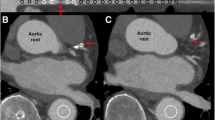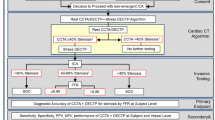Abstract
We assessed the diagnostic performance of stress- and rest-dual-energy computed tomography (DECT) and their incremental value when used with coronary CT angiography (CCTA) compared with combined invasive coronary angiography (ICA)/cardiovascular magnetic resonance (CMR) for detecting hemodynamically significant stenosis causing a myocardial perfusion defect. Forty patients (30 men; mean age, 63.4 ± 8.8 years) with known or suspected coronary artery disease detected by CCTA underwent stress- and rest-DECT, CMR, and ICA. DECT iodine maps were compared with CMR on a per-segment and per-vessel basis. Diagnostic value of CCTA was assessed on a per-vessel basis before and after stress- and rest-DECT and compared to that of ICA/CMR. Compared to CMR, sensitivity, specificity, positive predictive value (PPV), and negative predictive value (NPV) of rest-DECT for detecting segment (vessel)-based perfusion defects were 29 % (46 %), 88 % (79 %), 56 % (61 %), and 70 % (67 %), respectively. Corresponding values using stress-DECT were 73 % (94 %), 83 % (74 %), 70 % (72 %), and 85 % (95 %), respectively. There was fair (κ = 0.39) agreement between rest- and stress-DECT iodine maps in identifying segments with perfusion defects. Compared with the ICA/CMR for identifying hemodynamically significant stenoses, per-vessel territory sensitivity, specificity, PPV, and NPV of CCTA were 91, 56, 55, and 91 %, respectively; those using CCTA/rest-DECT were 42, 83, 59, and 70 %, respectively; and those using CCTA/stress-DECT were 87, 79, 71, and 91 %, respectively. The area under the receiver operating characteristic curve decreased from 0.74 to 0.62 (P = 0.06) using CCTA/rest-DECT but increased to 0.83 (P = 0.02) using CCTA/stress-DECT. Stress-DECT has incremental value when used with CCTA for detecting hemodynamically significant stenoses.





Similar content being viewed by others
Abbreviations
- CAD:
-
Coronary artery disease
- CCTA:
-
Coronary computed tomography angiography
- CMR:
-
Cardiovascular magnetic resonance
- DECT:
-
Dual-energy computed tomography
- ECG:
-
Electrocardiography
- FFR:
-
Fractional flow reserve
- ICA:
-
Invasive coronary angiography
- LAD:
-
Left anterior descending coronary artery
- LCX:
-
Left circumflex artery
- RCA:
-
Right coronary artery
- SPECT:
-
Single-photon emission computed tomography
References
Santana CA, Garcia EV, Faber TL et al (2009) Diagnostic performance of fusion of myocardial perfusion imaging (MPI) and computed tomography coronary angiography. J Nucl Cardiol 16(2):201–211
Gaemperli O, Schepis T, Valenta I et al (2007) Cardiac image fusion from stand-alone SPECT and CT: clinical experience. J Nucl Med 48(5):696–703
van Werkhoven JM, Heijenbrok MW, Schuijf JD et al (2010) Combined non-invasive anatomical and functional assessment with MSCT and MRI for the detection of significant coronary artery disease in patients with an intermediate pre-test likelihood. Heart 96(6):425–431
Donati OF, Scheffel H, Stolzmann P et al (2010) Combined cardiac CT and MRI for the comprehensive workup of hemodynamically relevant coronary stenoses. AJR Am J Roentgenol 194(4):920–926
Kurata A, Mochizuki T, Koyama Y et al (2005) Myocardial perfusion imaging using adenosine triphosphate stress multi-slice spiral computed tomography: alternative to stress myocardial perfusion scintigraphy. Circ J 69(5):550–557
Blankstein R, Shturman LD, Rogers IS et al (2009) Adenosine-induced stress myocardial perfusion imaging using dual-source cardiac computed tomography. J Am Coll Cardiol 54(12):1072–1084
George RT, Arbab-Zadeh A, Miller JM et al (2009) Adenosine stress 64- and 256-row detector computed tomography angiography and perfusion imaging: a pilot study evaluating the transmural extent of perfusion abnormalities to predict atherosclerosis causing myocardial ischemia. Circ Cardiovasc Imaging 2(3):174–182
Rocha-Filho JA, Blankstein R, Shturman LD et al (2010) Incremental value of adenosine-induced stress myocardial perfusion imaging with dual-source CT at cardiac CT angiography. Radiology 254(2):410–419
George RT, Arbab-Zadeh A, Miller JM et al (2012) Computed tomography myocardial perfusion imaging with 320-row detector computed tomography accurately detects myocardial ischemia in patients with obstructive coronary artery disease. Circ Cardiovasc Imaging 5(3):333–340
Ko BS, Cameron JD, Meredith IT et al (2012) Computed tomography stress myocardial perfusion imaging in patients considered for revascularization: a comparison with fractional flow reserve. Eur Heart J 33(1):67–77
Wang Y, Qin L, Shi X et al (2012) Adenosine-stress dynamic myocardial perfusion imaging with second-generation dual-source CT: comparison with conventional catheter coronary angiography and SPECT nuclear myocardial perfusion imaging. AJR Am J Roentgenol 198(3):521–529
Schwarz F, Ruzsics B, Schoepf UJ et al (2008) Dual-energy CT of the heart: principles and protocols. Eur J Radiol 68(3):423–433
Ruzsics B, Lee H, Zwerner PL et al (2008) Dual-energy CT of the heart for diagnosing coronary artery stenosis and myocardial ischemia-initial experience. Eur Radiol 18(11):2414–2424
Ruzsics B, Schwarz F, Schoepf UJ et al (2009) Comparison of dual-energy computed tomography of the heart with single photon emission computed tomography for assessment of coronary artery stenosis and of the myocardial blood supply. Am J Cardiol 104(3):318–326
Wang R, Yu W, Wang Y et al (2011) Incremental value of dual-energy CT to coronary CT angiography for the detection of significant coronary stenosis: comparison with quantitative coronary angiography and single photon emission computed tomography. Int J Cardiovasc Imaging 27(5):647–656
Ko SM, Choi JW, Song MG et al (2011) Myocardial perfusion imaging using adenosine-induced stress dual-energy computed tomography of the heart: comparison with cardiac magnetic resonance imaging and conventional coronary angiography. Eur Radiol 21(1):26–35
Raff GL, Abidov A, Achenbach S et al (2009) SCCT guidelines for the interpretation and reporting of coronary computed tomographic angiography. J Cardiovasc Comput Tomogr 3(2):122–136
Cerqueira MD, Weissman NJ, Dilsizian V et al (2002) Standardized myocardial segmentation and nomenclature for tomographic imaging of the heart. A statement for healthcare professionals from the Cardiac Imaging Committee of the Council on Clinical Cardiology of the American Heart Association. Circulation 105(4):539–542
Pilz G, Klos M, Ali E et al (2008) Angiographic correlations of patients with small vessel disease diagnosed by adenosine-stress cardiac magnetic resonance imaging. J Cardiovasc Magn Reson 10:8
Hausleiter J, Meyer T, Hermann F et al (2009) Estimated radiation dose associated with cardiac CT angiography. JAMA 301(5):500–507
Arnoldi E, Lee YS, Ruzsics B et al (2011) CT detection of myocardial blood volume deficits: dual-energy CT compared with single-energy CT spectra. J Cardiovasc Comput Tomogr 5(6):421–429
Hachamovitch R, Berman DS, Kiat H et al (1996) Exercise myocardial perfusion SPECT in patients without known coronary artery disease: incremental prognostic value and use in risk stratification. Circulation 93(5):905–914
Heller GV, Calnon D, Dorbala S (2009) Recent advances in cardiac PET and PET/CT myocardial perfusion imaging. J Nucl Cardiol 16(6):962–969
Plein S, Kozerke S, Suerder D et al (2008) High spatial resolution myocardial perfusion cardiac magnetic resonance for the detection of coronary artery disease. Eur Heart J 29(17):2148–2155
Nandalur KR, Dwamena BA, Choudhri AF et al (2007) Diagnostic performance of stress cardiac magnetic resonance imaging in the detection of coronary artery disease: a meta-analysis. J Am Coll Cardiol 50(14):1343–1353
Task Force on Myocardial Revascularization of the European Society of Cardiology (ESC) and the European Association for Cardio-Thoracic Surgery (EACTS); European Association for Percutaneous Cardiovascular Interventions (EAPCI), Wijns W, Kolh P et al (2010) Guidelines on myocardial revascularization. Eur Heart J 31(20):2501–2555
Watkins S, McGeoch R, Lyne J et al (2009) Validation of magnetic resonance myocardial perfusion imaging with fractional flow reserve for the detection of significant coronary heart disease. Circulation 120(22):2207–2213
Ko SM, Choi JW, Hwang HK et al (2012) Diagnostic performance of combined noninvasive anatomic and functional assessment with dual-source CT and adenosine-induced stress dual-energy CT for detection of significant coronary stenosis. AJR Am J Roentgenol 198(3):512–520
Feuchtner G, Goetti R, Plass A et al (2011) Adenosine stress high-pitch 128-slice dual-source myocardial computed tomography perfusion for imaging of reversible myocardial ischemia: comparison with magnetic resonance imaging. Circ Cardiovasc Imaging 4(5):540–549
Nagao M, Matsuoka H, Kawakami H et al (2008) Quantification of myocardial perfusion by contrast-enhanced 64-MDCT: characterization of ischemic myocardium. AJR Am J Roentgenol 191(1):19–25
Bischoff B, Bamberg F, Marcus R et al (2013) Optimal timing for first-pass stress CT myocardial perfusion imaging. Int J Cardiovasc Imaging 29(2):435–442
Nieman K, Shapiro MD, Ferencik M et al (2008) Reperfused myocardial infarction: contrast-enhanced 64-Section CT in comparison to MR imaging. Radiology 247(1):49–56
Kochar M, Min JK (2013) Physiologic assessment of coronary artery disease by cardiac computed tomography. Korean Circ J 43(7):435–442
Techasith T, Cury RC (2011) Stress myocardial CT perfusion: an update and future perspective. JACC Cardiovasc Imaging 4(8):905–916
Acknowledgments
This work was supported by Konkuk University.
Conflict of interest
None.
Author information
Authors and Affiliations
Corresponding author
Rights and permissions
About this article
Cite this article
Ko, S.M., Park, J.H., Hwang, H.K. et al. Direct comparison of stress- and rest-dual-energy computed tomography for detection of myocardial perfusion defect. Int J Cardiovasc Imaging 30 (Suppl 1), 41–53 (2014). https://doi.org/10.1007/s10554-014-0410-3
Received:
Accepted:
Published:
Issue Date:
DOI: https://doi.org/10.1007/s10554-014-0410-3




